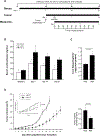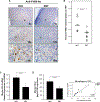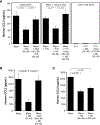Stress-induced Norepinephrine Downregulates CCL2 in Macrophages to Suppress Tumor Growth in a Model of Malignant Melanoma
- PMID: 32518084
- PMCID: PMC7607650
- DOI: 10.1158/1940-6207.CAPR-19-0370
Stress-induced Norepinephrine Downregulates CCL2 in Macrophages to Suppress Tumor Growth in a Model of Malignant Melanoma
Abstract
Psychological stressors have been implicated in the progression of various tumor types. We investigated a role for stress in tumor immune cell chemotaxis in the B16F10 mouse model of malignant melanoma. We exposed female mice to 6-hour periods of restraint stress (RST) for 7 days, then implanted B16F10 malignant melanoma tumor cells and continued the RST paradigm for 14 additional days. We determined serum corticosterone and liver catecholamine concentrations in these mice. To evaluate the tumor microenvironment, we performed IHC and examined cytokine expression profiles using ELISA-based analysis of tumor homogenates. We found that tumors in mice subjected to RST grew significantly slower, had reduced tumor C-C motif ligand 2 (CCL2), and contained fewer F4/80-positive macrophages than tumors from unstressed mice. We observed a concomitant increase in norepinephrine among the RST mice. An in vitro assay confirmed that norepinephrine downregulates CCL2 production in both mouse and human macrophages, and that pretreatment with the pan-β-adrenergic receptor inhibitor nadolol rescues this activity. Furthermore, RST had no effect on tumor growth in transgenic CCL2-deficient mice. This study suggests that stress reduces malignant melanoma by reducing recruitment of tumor-promoting macrophages by CCL2.
©2020 American Association for Cancer Research.
Conflict of interest statement
Disclosure of Potential Conflicts of Interest
No potential conflicts of interest were disclosed.
Figures






Similar articles
-
Anti-tumor immune response varies among individuals: A gene expression profiling of mouse melanoma.Int Immunopharmacol. 2020 Mar;80:106211. doi: 10.1016/j.intimp.2020.106211. Epub 2020 Jan 20. Int Immunopharmacol. 2020. PMID: 31972424
-
Immunomodulatory Effect of Imiquimod Through CCL22 Produced by Tumor-associated Macrophages in B16F10 Melanomas.Anticancer Res. 2017 Jul;37(7):3461-3471. doi: 10.21873/anticanres.11714. Anticancer Res. 2017. PMID: 28668835
-
STC1 competitively binding βPIX enhances melanoma progression via YAP nuclear translocation and M2 macrophage recruitment through the YAP/CCL2/VEGFA/AKT feedback loop.Pharmacol Res. 2024 Jun;204:107218. doi: 10.1016/j.phrs.2024.107218. Epub 2024 May 18. Pharmacol Res. 2024. PMID: 38768671
-
Epithelial-mesenchymal-transition-like and TGFβ pathways associated with autochthonous inflammatory melanoma development in mice.PLoS One. 2012;7(11):e49419. doi: 10.1371/journal.pone.0049419. Epub 2012 Nov 16. PLoS One. 2012. PMID: 23173060 Free PMC article.
-
A Genomic Profile of Local Immunity in the Melanoma Microenvironment Following Treatment with α Particle-Emitting Ultrasmall Silica Nanoparticles.Cancer Biother Radiopharm. 2020 Aug;35(6):459-473. doi: 10.1089/cbr.2019.3150. Epub 2020 Feb 3. Cancer Biother Radiopharm. 2020. PMID: 32013538 Free PMC article.
Cited by
-
Neuroimmune Interactions and Their Role in Immune Cell Trafficking in Cardiovascular Diseases and Cancer.Int J Mol Sci. 2025 Mar 12;26(6):2553. doi: 10.3390/ijms26062553. Int J Mol Sci. 2025. PMID: 40141195 Free PMC article. Review.
-
Adrenergic signaling regulation of macrophage function: do we understand it yet?Immunother Adv. 2022 Jun 1;2(1):ltac010. doi: 10.1093/immadv/ltac010. eCollection 2022. Immunother Adv. 2022. PMID: 36284839 Free PMC article. Review.
-
CC Chemokine Receptor 4 (CCR4) as a Possible New Target for Therapy.Int J Mol Sci. 2022 Dec 9;23(24):15638. doi: 10.3390/ijms232415638. Int J Mol Sci. 2022. PMID: 36555280 Free PMC article. Review.
-
Locus coeruleus injury modulates ventral midbrain neuroinflammation during DSS-induced colitis.Res Sq [Preprint]. 2024 Mar 12:rs.3.rs-3952442. doi: 10.21203/rs.3.rs-3952442/v1. Res Sq. 2024. PMID: 38559083 Free PMC article. Preprint.
-
Roles of CCL2-CCR2 Axis in the Tumor Microenvironment.Int J Mol Sci. 2021 Aug 8;22(16):8530. doi: 10.3390/ijms22168530. Int J Mol Sci. 2021. PMID: 34445235 Free PMC article. Review.
References
-
- Kiecolt-Glaser JK, Marucha PT, Mercado AM, Malarkey WB and Glaser R. Slowing of wound healing by psychological stress. The Lancet 1995;346(8984), pp.1194–1196. - PubMed
-
- Frick LR, Barreiro Arcos ML, Rapanelli M, Zappia MP, Brocco M, Mongini C. et al. Chronic restraint stress impairs T-cell immunity and promotes tumor progression in mice. Stress 2009;12(2), pp.134–143. - PubMed
-
- Guirao X, Kumar A, Katz J, Smith M, Lin E, Keogh C. et al. Catecholamines increase monocyte TNF receptors and inhibit TNF through β2- adrenoreceptor activation. American Journal of Physiology-Endocrinology And Metabolism 1997;273(6), pp.E1203–E1208. - PubMed
-
- Torisu H, Ono M, Kiryu H, Furue M, Ohmoto Y, Nakayama J. et al. Macrophage infiltration correlates with tumor stage and angiogenesis in human malignant melanoma: Possible involvement of TNFα and IL-1α. International journal of cancer 2000;85(2), pp.182–188. - PubMed
Publication types
MeSH terms
Substances
Grants and funding
LinkOut - more resources
Full Text Sources
Medical

